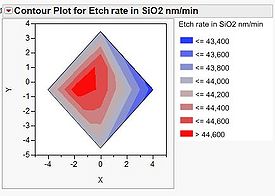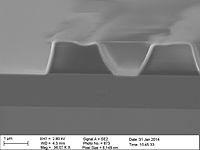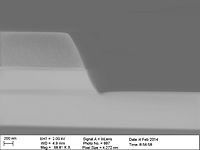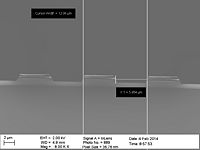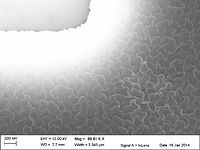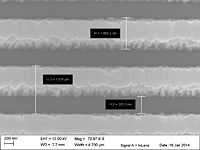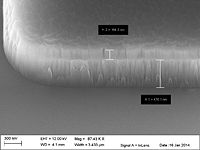Specific Process Knowledge/Etch/ICP Metal Etcher/silicon oxide: Difference between revisions
No edit summary |
|||
| Line 1: | Line 1: | ||
'''Feedback to this page''': '''[mailto:labadviser@ | '''Feedback to this page''': '''[mailto:labadviser@nanolab.dtu.dk?Subject=Feed%20back%20from%20page%20http://labadviser.nanolab.dtu.dk/index.php/Specific_Process_Knowledge/Etch/ICP_Metal_Etcher/silicon_oxide click here]''' | ||
It is possible to etch SiO2 in the ICP metal etcher but it is not designed for it and the results are not fantastic. It is a challenge to get a good selectivity to resist (typically in the range of 1:1 or worse) and it is probably not possible to get a profile angle of 90 degrees. More likely about 75-85 degrees. Different chemistries can be applied either based on CF4 or C4F8. If seems that C4F8 can give the best selectivity to resist (best case I have seem was 1:11 but it depends a lot on the process parameters)). If low coil power is needed CF4 chemistry is used because C4F8 needs a higher power to generate a plasma. ''/bghe 2016-04-25 '' | It is possible to etch SiO2 in the ICP metal etcher but it is not designed for it and the results are not fantastic. It is a challenge to get a good selectivity to resist (typically in the range of 1:1 or worse) and it is probably not possible to get a profile angle of 90 degrees. More likely about 75-85 degrees. Different chemistries can be applied either based on CF4 or C4F8. If seems that C4F8 can give the best selectivity to resist (best case I have seem was 1:11 but it depends a lot on the process parameters)). If low coil power is needed CF4 chemistry is used because C4F8 needs a higher power to generate a plasma. ''/bghe 2016-04-25 '' | ||
| Line 35: | Line 35: | ||
|-style="background:Black; color:White" | |-style="background:Black; color:White" | ||
!Results | !Results | ||
!Test on wafer with 50% load (Travka 50), by BGHE @ | !Test on wafer with 50% load (Travka 50), by BGHE @nanolab | ||
!100% load on 100mm wafers with Barc and KRF (no mask) | !100% load on 100mm wafers with Barc and KRF (no mask) | ||
|- | |- | ||
| Line 145: | Line 145: | ||
|- | |- | ||
|SEM profile images | |SEM profile images | ||
|[[File:ICP metal s007592_21.jpg|200px]] [[File:ICP metal s007592_24.jpg|200px]]<br> ''by bghe@ | |[[File:ICP metal s007592_21.jpg|200px]] [[File:ICP metal s007592_24.jpg|200px]]<br> ''by bghe@nanolab (2015-06-02)'' | ||
|- | |- | ||
|Etch rate in barc | |Etch rate in barc | ||
| Line 151: | Line 151: | ||
|- | |- | ||
|Etch rate in KRF resist | |Etch rate in KRF resist | ||
|34 nm/min ''by bghe@ | |34 nm/min ''by bghe@nanolab (2015-06-02)'' | ||
|- | |- | ||
|Comments | |Comments | ||
| | | | ||
*Sample: s007592 ''by bghe@ | *Sample: s007592 ''by bghe@nanolab (2015-06-02)'' | ||
*See Martin Lind Ommen's results with hard masks in Process2share: [http://process2share. | *See Martin Lind Ommen's results with hard masks in Process2share: [http://process2share.nanolab.dtu.dk/index.php/Specific_Process_Knowledge/Etch/Etching_of_SiO2] <br> There were problems with polymer on the surface after etching. | ||
|} | |} | ||
| Line 191: | Line 191: | ||
|-style="background:Black; color:White" | |-style="background:Black; color:White" | ||
!Results | !Results | ||
!Test on wafer with 50% load (Travka 50), by BGHE @ | !Test on wafer with 50% load (Travka 50), by BGHE @nanolab | ||
|- | |- | ||
|Etch rate of thermal oxide | |Etch rate of thermal oxide | ||
| Line 234: | Line 234: | ||
**same step size: 20nm | **same step size: 20nm | ||
**px1283mk: alignment mark for finfet | **px1283mk: alignment mark for finfet | ||
**dose 280uc 3x3 at x pitch 10mm y | **dose 280uc 3x3 at x pitch 10mm y pitch 10 mm in wafer center | ||
px1283lablejan1542014t1 250uc | px1283lablejan1542014t1 250uc | ||
at 40mm x y | at 40mm x y | ||
| Line 246: | Line 246: | ||
**494.53nm | **494.53nm | ||
**SiO2 etched 1152-495=657nm | **SiO2 etched 1152-495=657nm | ||
**SiO2 etch rate: | **SiO2 etch rate: 131 nm/min | ||
*sem zeiss, 1:50am Jan162014 still as over | *sem zeiss, 1:50am Jan162014 still as over 200 nm zep remains on the wafer for line400p1000, need high dose as 320uc. 280uc is not enough to go through 560 nm thick zep520A | ||
|- | |- | ||
|} | |} | ||
Revision as of 19:18, 25 November 2019
Feedback to this page: click here
It is possible to etch SiO2 in the ICP metal etcher but it is not designed for it and the results are not fantastic. It is a challenge to get a good selectivity to resist (typically in the range of 1:1 or worse) and it is probably not possible to get a profile angle of 90 degrees. More likely about 75-85 degrees. Different chemistries can be applied either based on CF4 or C4F8. If seems that C4F8 can give the best selectivity to resist (best case I have seem was 1:11 but it depends a lot on the process parameters)). If low coil power is needed CF4 chemistry is used because C4F8 needs a higher power to generate a plasma. /bghe 2016-04-25
Slow etch of SiO2 with resist as masking material - using a 6" carrier wafer with recess
This recipe can be used for slow etching of SiO2 with resist as masking material. Here are some test results presented.
| Parameter | Resist mask |
|---|---|
| Coil Power [W] | 200 |
| Platen Power [W] | 25 |
| Platen temperature [oC] | 0 |
| CF4 flow [sccm] | 20 |
| H2 flow [sccm] | 10 |
| Pressure [mTorr] | 3 |
SiO2 etch using DUV mask
Two chemistry regimes has been explored: One using CF4 and one using C4F8
- CF4: bad selectivity to the resist mask.
- C4F8: Better selectivity to the resist mask can be achieved
- Tests done by Peixiong
- Tests done by Berit
- Test by Zhibo Li @Danchip dec. 2016 - based on the work of Peixiong and Berit: File:Zhibo Li SiO2 ICP etch (dose205).docx
| Parameter | Recipe on ICP metal: A SiO2 etch with C4F8 with resist mask |
|---|---|
| Coil Power [W] | 1000 |
| Platen Power [W] | 200 |
| Platen temperature [oC] | 0 |
| C4F8 flow [sccm] | 10 |
| H2 flow [sccm] | 28 |
| Pressure [mTorr] | 2.5 |
| Results | Test |
|---|---|
| Etch rate of thermal oxide |
|
| Selectivity to resist [:1] | 4-5:1 (SiO2:resist) by bghe@danchip (2015-06-02) |
| Cr etch rate | 1.6 nm/min (1:90 to SiO2) by Martin Lind Ommen (fall 2016) |
| Profile [o] | 86-87 dg by bghe@danchip (2015-06-02) |
| Wafer uniformity map (click on the image to view a larger image) | |
| SEM profile images |  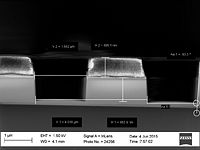 by bghe@nanolab (2015-06-02) |
| Etch rate in barc | |
| Etch rate in KRF resist | 34 nm/min by bghe@nanolab (2015-06-02) |
| Comments |
|
SiO2 etch nLOF
| Parameter | Resist mask |
|---|---|
| Coil Power [W] | 800 |
| Platen Power [W] | 100 |
| Platen temperature [oC] | 0 |
| CF4 flow [sccm] | 30 |
| H2 flow [sccm] | 10 |
| Pressure [mTorr] | 4 |
| Results | Test on wafer with 50% load (Travka 50), by BGHE @nanolab |
|---|---|
| Etch rate of thermal oxide | >110 nm/min (50% etch load) (09-03-2015) |
| Selectivity to resist [:1] | <0.7:1 (SiO2:resist) |
| Wafer uniformity (100mm) | Not known |
| Profile [o] | Not known |
| Wafer uniformity map (click on the image to view a larger image) | Not known |
| SEM profile images | NONE |
| Etch rate in nLOF resist | 1.6µm was removed after 10min |
| Comment | After 10min etch the resist was gone and the etch depth as 1.145µm in the oxide |
SiO2 etch with e-beam resist
| Process flow |
|---|
px1283lablejan1542014t1 250uc at 40mm x y pxline400p1000jan142014dt2 y= -40 -45 -50 -55mm dose 200 240 280 320uc
|
| Parameter | Resist mask |
|---|---|
| Coil Power [W] | 800 |
| Platen Power [W] | 150 |
| Platen temperature [oC] | -10 |
| C4F8 flow [sccm] | 8 |
| H2 flow [sccm] | 30 |
| Pressure [mTorr] | 2.5 |
| Results | Test on 6" wafer, by Peixiong Shi@danchip |
|---|---|
| Etch rate of thermal oxide | 131 nm/min (15-01-2014) |
| Selectivity to resist [:1] | ~1.8:1 (SiO2:resist) |
| Profile [o] | Not measured |
| Wafer uniformity map (click on the image to view a larger image) | Not known |
| SEM images |
|

